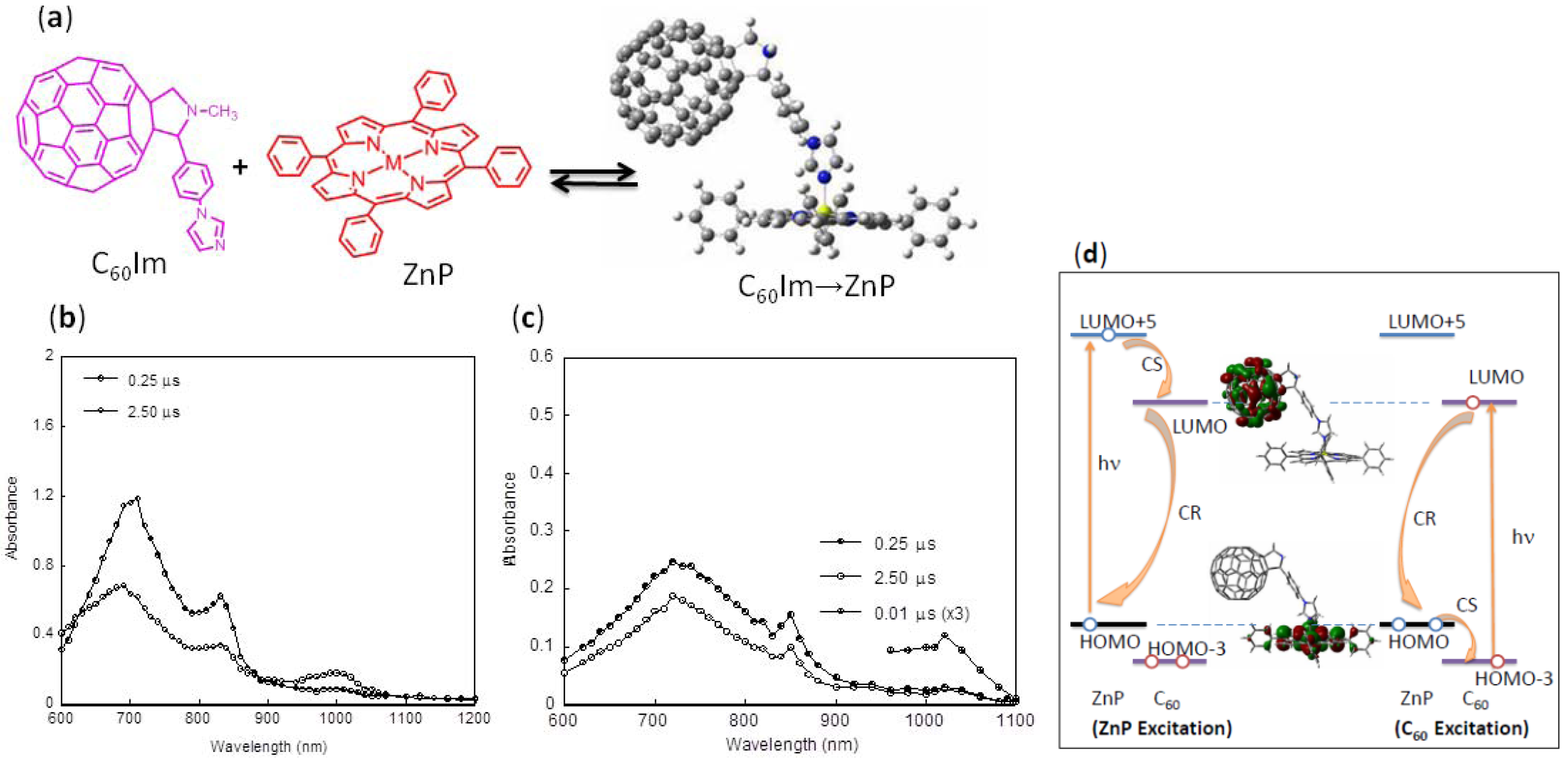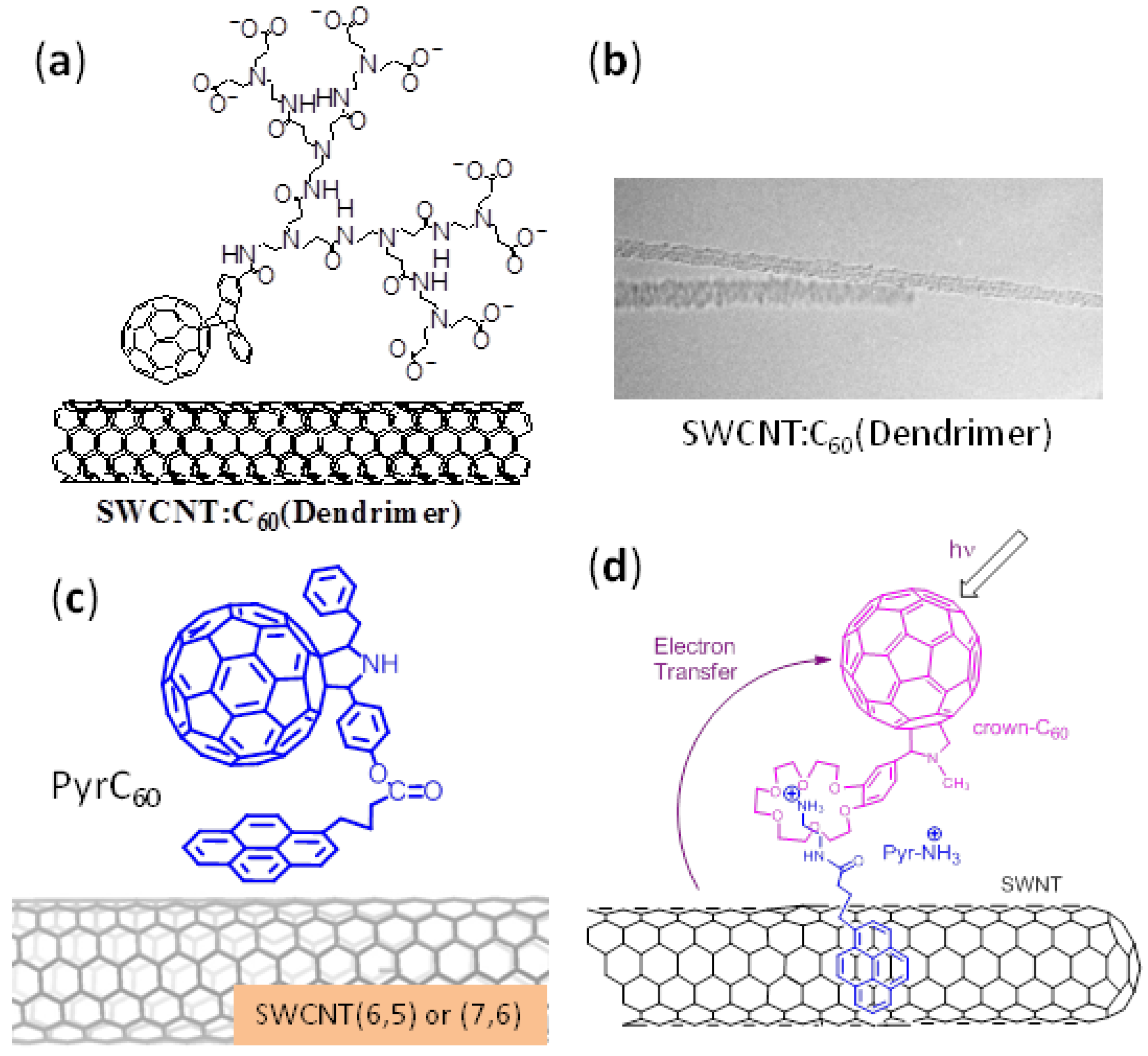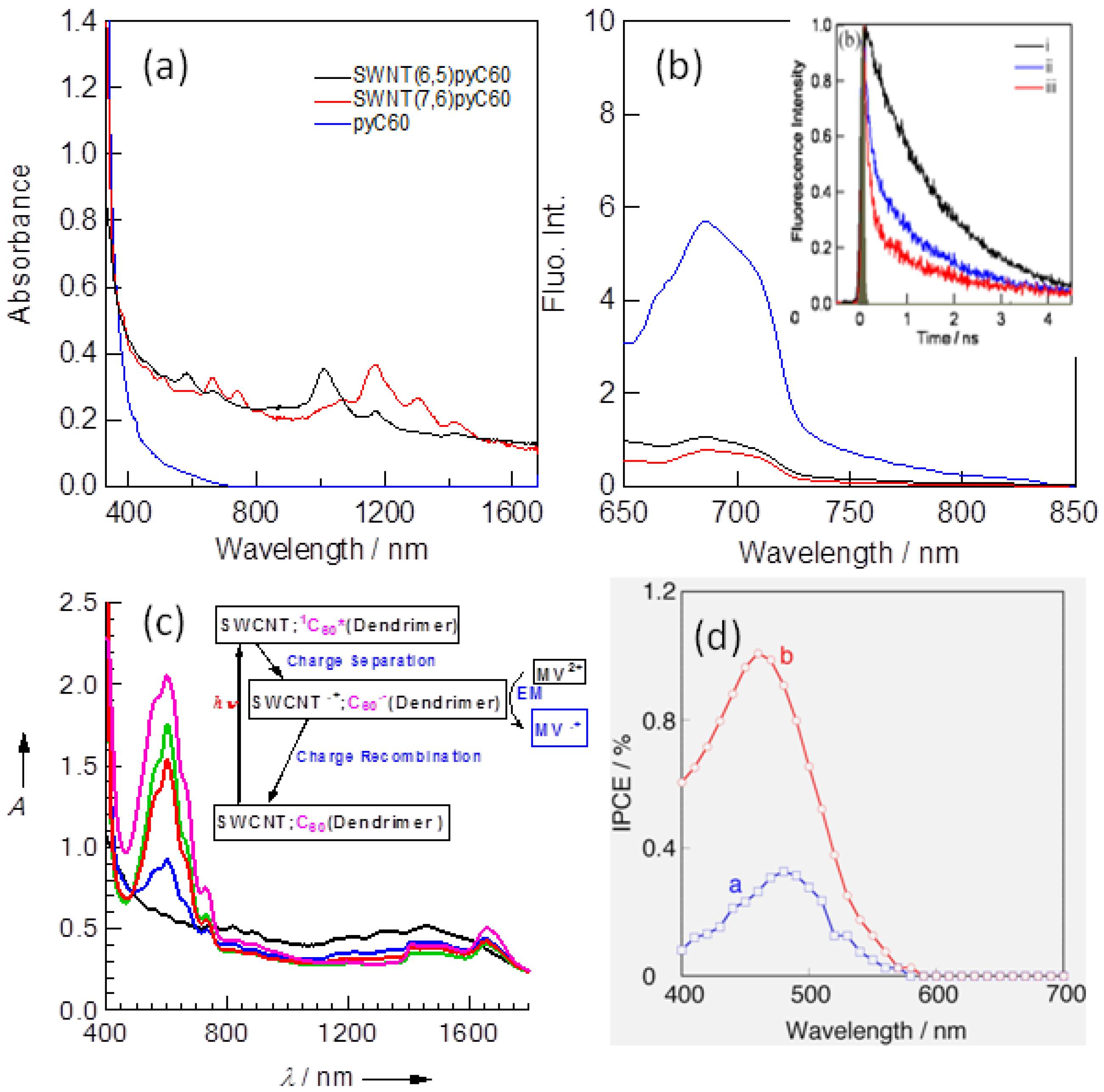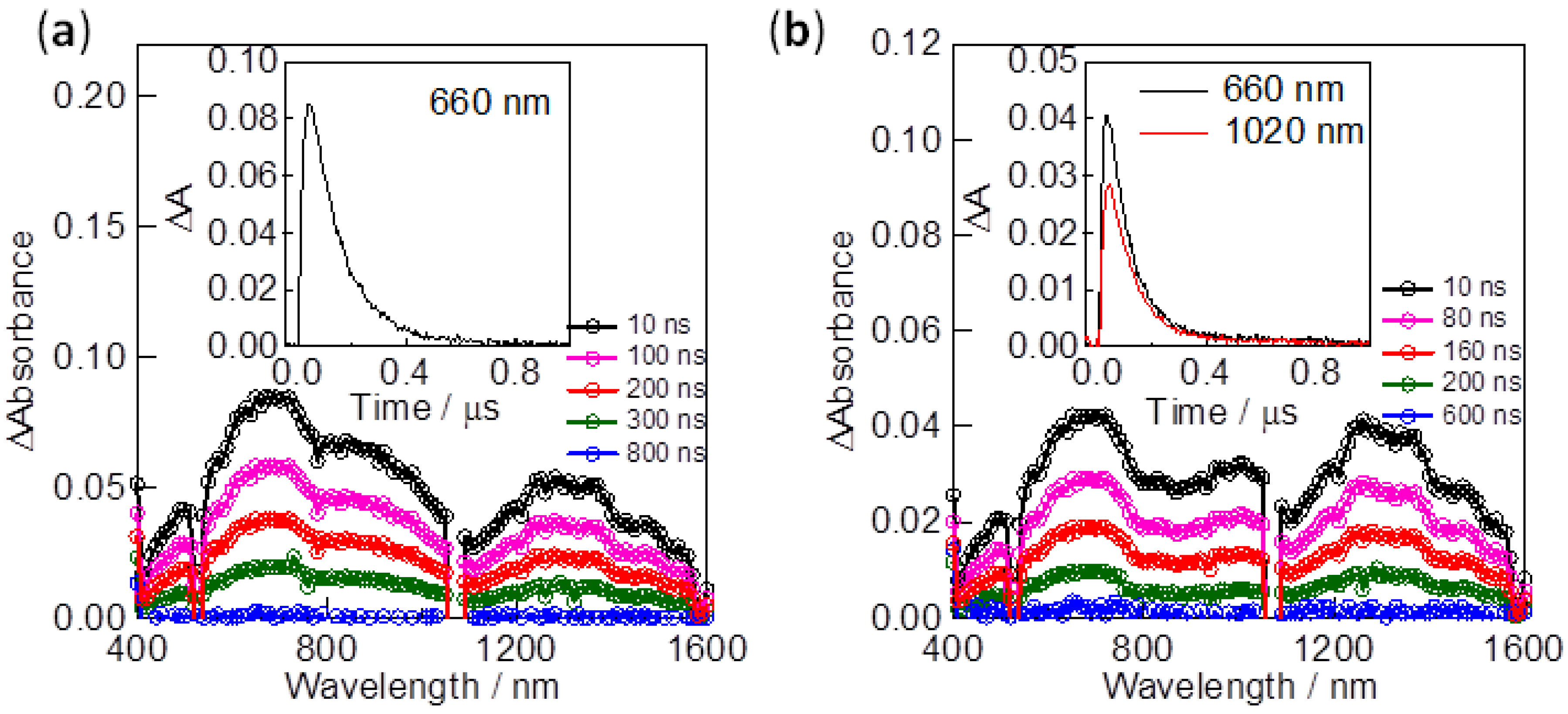Recent Advances in Photoinduced Electron Transfer Processes of Fullerene-Based Molecular Assemblies and Nanocomposites
Abstract
:1. Introduction

2. Fullerene-Porphyrin Systems
2.1. Fullerene-Porphyrin Coordination Systems

2.2. Fullerene-Porphyrin Charge-Transfer Systems

3. Fullerene-SWCNT Systems
3.1. Fullerene-SWCNT Systems

3.2. Steady-State Spectral Studies of Fullerene-SWCNT Systems

3.3. Direct Evidence for Charge Separation of Fullerene-SWCNT Systems

4. Fullerene-Porphyrin-SWCNT Systems
4.1. Molecular Structure and Energy Level Diagram

4.2. Evidence for Photoinduced Charge Separation

4.3. Photoelectrochemical Studies

5. Conclusions
Acknowledgments
References and Notes
- Ito, O. Electron-Transfer Processes of Fullerenes Studied with Time-Resolved Spectroscopies. In Fullerenes, Principles and Applications, 2nd ed.; Langa, F., Nierengarten, J.-F., Eds.; RCS Publishing: Cambridge, UK, 2012; Volume 2, pp. 270–328, Chapter 8. [Google Scholar]
- D’Souza, F.; Ito, O. Electron Transfer in Self-assembled Supramolecular Fullerene Based Donor-Acceptor Conjugates. In Handbook of Organic Electronics and Photonics; Nalwa, H.R., Ed.; American Scientific Publishers: Valencia, CA, USA, 2008; Volume 1, pp. 485–521, Chapter 13. [Google Scholar]
- D’Souza, F.; Ito, O. Tetrapyrrole-Nanocarbon Hybrids: Self-Assembly and Photoinduced Electron Transfer. In Handbook of Porphyrin Science; Kadish, K.M., Smith, K.M., Guilard, R., Eds.; World Scientific Publishing: Singapore, 2010; Volume 1, pp. 307–437. [Google Scholar]
- D’Souza, F.; Ito, O. Multiporphyrins-Fullerenes and Multiporphyrins-SWCNTs Mimicking Photosynthetic Antenna-Reaction Center. In Multiporphyrin Arrays; Kim, D., Ed.; Pan Stanford Publishing: Singapore, 2012; pp. 389–438, Chapter 8. [Google Scholar]
- D’Souza, F.; Ito, O. Photosensitized electron transfer processes of nanocarbons applicable to solar cells. Chem. Soc. Rev. 2012, 41, 86–96. [Google Scholar] [CrossRef]
- D’Souza, F.; Sandanayaka, A.S.D.; Ito, O. SWNT-based supramolecular nanoarchitectures with photosensitizing donor and acceptor molecules. J. Phys. Chem. Lett. 2010, 1, 2586–2593. [Google Scholar] [CrossRef]
- Chitta, R.; D’Souza, F. Self-assembled tetrapyrrole-fullerene and tetrapyrrole-carbon nanotube donor-acceptor hybrids for light induced electron transfer applications: A review. J. Mater. Chem. 2008, 18, 1440–1471. [Google Scholar] [CrossRef]
- D’Souza, F.; Ito, O. Supramolecular donor-acceptor hybrids of porphyrins/phthalocyanines with fullerenes/carbon nanotubes: Electron transfer, sensing, switching, and catalytic applications. Chem. Commun. 2009, 45, 4913–4928. [Google Scholar]
- Handbook of Carbon Nano Materials; D’Souza, F.; Kadish, K.M. (Eds.) World Scientific: Singapore, 2011; 12.
- Sgobba, V.; Rahman, G.M.A.; Guldi, D.M. Carbon Nanotubes in Electron Donor-Acceptor Nanocomposites. In Chemistry of Carbon Nanotubes; Basiuk, V.A., Basiuk, E.V., Eds.; American Scientific Publishers: Valencia, CA, USA, 2007; Volume 2, pp. 109–147, Chapter 6. [Google Scholar]
- Sgobba, V.; Guldi, D.M. Carbon nanotubes-electronic/electrochemical properties and application for nanoelectronics and photonics. Chem. Soc. Rev. 2009, 38, 165–184. [Google Scholar] [CrossRef]
- Bottair, G.; de la Torre, G.; Guldi, D.M.; Torres, T. Covalent and noncovalent phthalocyanine-carbon nanostructure systems: Synthesis, photoinduced electron transfer, and applivcation to molecular photovoltaics. Chem. Rev. 2010, 110, 6768–6816. [Google Scholar] [CrossRef]
- Fukuzumi, S.; Kojima, T. Photofunctional nanomasterials composed of multiprophyrins and carbon-based π-electron acceptors. J. Mater. Chem. 2008, 18, 1427–1439. [Google Scholar] [CrossRef]
- Tasis, D.; Tagmatarchis, N.; Bianco, A.; Prato, M. Chemistry of carbon nanotubes. Chem. Rev. 2006, 106, 1105–1136. [Google Scholar] [CrossRef]
- Harris, P.J.F. Carbon Nanotubes and Related Structures: New Materials for the Twenty-First Century; Cambridge University Press: Cambridge, UK, 2001. [Google Scholar]
- Delgado, J.L.; Herranz, M.Á.; Martín, N. The nano-forms of carbon. J. Mater. Chem. 2008, 18, 1417–1426. [Google Scholar] [CrossRef]
- Gust, D.; Moore, T.A.; Moore, A.L. Solar fuels via artificial photosynthesis. Acc. Chem. Res. 2009, 42, 1890–1898. [Google Scholar] [CrossRef]
- Fukuzumi, S.; Imahori, H. Biomimetic Electron-Transfer Chemistry of Porphyrins and Metalloporphyrins. In Electron Transfer in Chemistry; Balzani, V., Ed.; Wiley-VCH: Weinheim, Germany, 2000; Volume 2, pp. 927–975. [Google Scholar]
- Guldi, D.M. Fullerene-porphyrin architectures; Photosynthetic antenna and reaction center models. Chem. Soc. Rev. 2002, 31, 22–36. [Google Scholar] [CrossRef]
- Wasielewski, M.R. Photoinduced electron transfer in supramolecular systems for artificial photosynthesis. Chem. Rev. 1992, 92, 435–461. [Google Scholar] [CrossRef]
- Umeyama, T.; Imahori, H. Carbon nanotube-modified electrodes for solar energy conversion. Energy Environ. Sci. 2008, 1, 120–133. [Google Scholar] [CrossRef]
- Kamat, P.V. Meeting the clean energy demand: Nanostructure architectures for solar energy conversion. J. Phys. Chem. C 2007, 111, 2834–2860. [Google Scholar] [CrossRef]
- Hasobe, T. Supramolecular nanoarchitectures for light energy conversion. Phys. Chem. Chem. Phys. 2010, 12, 44–57. [Google Scholar] [CrossRef]
- D’Souza, F.; Das, S.K.; Zandler, M.E.; Sandanayaka, A.S.D.; Ito, O. Bio-nano donor-acceptor hybrids of porphyrin, ssDNA and semiconductive SWCNT for electron transfer via porphyrin excitation. J. Am. Chem. Soc. 2011, 133, 19922–19930. [Google Scholar]
- D’Souza, F.; Amin, A.N.; El-Khouly, M.E.; Subbaiyan, N.K.; Zandler, M.E.; Fukuzumi, S. Control over photoinduced energy and electron transfer in supramolecular polyads of covalently linked azaBODIPY-bisporphyrin. Molecular clip hosting fullerene. J. Am. Chem. Soc. 2012, 134, 654–664. [Google Scholar]
- Carbon Nanotubes: Synthesis, Structure and Applications; Dresselhaus, M.S.; Dresselhaus, G.; Avouris, P. (Eds.) Springer Publishing: New York, NY, USA, 2001.
- Avouris, P. Molecular electronics with carbon nanotubes. Acc. Chem. Res. 2002, 35, 1026–1034. [Google Scholar] [CrossRef]
- D’Souza, F.; Ito, O. Photoinduced electron transfer in supramolecular systems of fullerenes functionalized with ligands capable of binding zinc porphyrins and zinc phthalocyanines. Coord. Chem. Rev. 2005, 249, 1410–1422. [Google Scholar] [CrossRef]
- D’Souza, F.; Deviprasad, G.R.; El-Khouly, M.E.; Fujitsuka, M.; Ito, O. Probing The Donor-Acceptor Proximity On The Physicochemical Properties Of Porphyrin-Fullerene Dyads: “Tail-On” And “Tail-Off” binding approach. J. Am. Chem. Soc. 2001, 123, 5277–5284. [Google Scholar] [CrossRef]
- D’Souza, F.; Gadde, S.; Zandler, M.E.; Arkady, K.; El-Khouly, M.E.; Fujitsuka, M.; Ito, O. Studies on covalently linked porphyrin-C60 dyads: Stabilization of charge-separated states by axial coordination. J. Phys. Chem. A 2002, 106, 12393–12404. [Google Scholar] [CrossRef]
- D’Souza, F.; Chitta, R.; Gadde, S.; Zandler, M.E.; McCarty, A.L.; Sandanayaka, A.S.D.; Araki, Y.; Ito, O. Effect of axial ligation or π−π interactions on the photochemical charge stabilization in the ‘two-point’ bound supramolecular porphyrin fullerene conjugates. Chem. Eur. J. 2005, 11, 4416–4428. [Google Scholar] [CrossRef]
- El-Khouly, M.E.; Araki, Y.; Ito, O.; Gadde, S.; McCarty, A.L.; Karr, P.A.; Zandler, M.E.; D’Souza, F. Synthesis and electron transfer reactions of a magnesium porphyrin-fullerene dyad. Phys. Chem. Chem. Phys. 2005, 7, 3163–3171. [Google Scholar]
- D’Souza, F.; El-Khouly, M.E.; Gadde, S.; Zandler, M.E.; McCarty, A.L.; Araki, Y.; Ito, O. Stable supramolecular triads via ‘two-point’ binding involving coordination and hydrogen bonding: Role of the second electron donor in charge stabilization. Tetrahedron 2006, 62, 1967–1978. [Google Scholar] [CrossRef]
- El-Khouly, M.E.; Araki, Y.; Fujitsuka, M.; Ito, O. Photoinduced electron transfer between metal octaethylporphyrins and fullerenes (C60/C70) studied by laser flash photolysis: electron-mediating and hole-shifting cycles. Phys. Chem. Chem. Phys. 2002, 4, 3322–3329. [Google Scholar]
- El-Khouly, M.E.; Ito, O.; Smith, P.M.; D’Souza, F. Intermolecular and supramolecular photoinduced electron transfer processes of fullerene-porphyrin/phthalocyanine systems. J. Photochem. Photobiol. C Photochem. Rev. 2004, 5, 79–104. [Google Scholar] [CrossRef]
- D’Souza, F.; Deviprasad, G.R.; Zandler, M.E.; Hoang, V.T.; Klykov, A.; van Stipdonk, M.; Perera, A.; El-Khouly, M.E.; Fujitsuka, M.; Ito, O. Spectroscopic, electrochemical, and photochemical studies of self-assembled via axial coordination zinc porphyrin-fulleropyrrolidine dyads. J. Phys. Chem. A 2002, 106, 3243–3252. [Google Scholar]
- El-Khouly, M.E.; Rogers, L.M.; Zandler, M.E.; Suresh, G.; Fujitsuka, M.; Ito, O.; D’Souza, F. Studies on intra-supramolecular and intermolecular electron-transfer processes between zinc naphthalocyanine and imidazole-appended fullerene. ChemPhysChem 2003, 4, 474–481. [Google Scholar] [CrossRef]
- D’Souza, F.; El-Khouly, M.E.; Gadde, S.; McCarty, A.L.; Karr, P.A.; Zandler, M.E.; Araki, Y.; Ito, O. A self-assembled via axial coordination magnesium porphyrin-imidazole appended fullerene dyad: Spectroscopic, electrochemical, computational and photochemical studies. J. Phys. Chem. B 2005, 109, 10107–10114. [Google Scholar]
- Sandanayaka, A.S.D.; Araki, Y.; Luo, C.; Fujitsuka, M.; Ito, O. Photoinduced electron-transfer processes of fullerene (C60) with amine donors: Excited triplet route vs. excited singlet route. Bull. Chem. Soc. Jpn. 2004, 77, 1313–1322. [Google Scholar] [CrossRef]
- Subbaiyan, N.K.; Gadde, S.; Ito, O.; D’Souza, F. University of North Texas: TX, USA, 2012; unpublished work.
- Zandler, M.E.; D’Souza, F. The remarkable ability of B3LYP/3-21G(*) calculations to describe geometric, spectral and electrochemical properties of supramolecular donor-acceptor porphyrin-fullerene conjugates. Compt. Rendus Chem. 2006, 9, 960–981. [Google Scholar] [CrossRef]
- Li, C.; Chen, Y.; Wang, Y.; Iqbal, Z.; Chhowalla, M.; Mitra, S. A fullerene-single wall carbon nanotube complex for polymer bulk heterojunction photovoltaic cells. J. Mater. Chem. 2007, 17, 2406–2411. [Google Scholar] [CrossRef]
- Takaguchi, Y.; Tamura, M.; Sako, Y.; Yanagimoto, Y.; Tsuboi, S.; Uchida, T.; Shimamura, K.; Kimura, S.; Wakahara, T.; Maeda, Y.; et al. Fullerodendron-assisted dispersion of single-walled carbon nanotubes via noncovalent functionalization. Chem. Lett. 2005, 34, 1608–1609. [Google Scholar] [CrossRef]
- Sandanayaka, A.S.D.; Takaguchi, Y.; Sako, Y.; Tamura, M.; Ito, O. Photoinduced electron transfer of single walled carbon nanotubes surrounded by fullerodendrimers in aqueous media. Adv. Sci. Lett. 2010, 3, 353–357. [Google Scholar] [CrossRef]
- D’Souza, F.; Chitta, R.; Sandanayaka, A.S.D.; Subbaiyan, N.K.; D’Souza, L.; Araki, Y.; Ito, O. supramolecular carbon nanotube-fullerene donor-acceptor hybrids for photoinduced electron transfer. J. Am. Chem. Soc. 2007, 129, 15865–15871. [Google Scholar]
- Sandanayaka, A.S.D.; Hasobe, T.; Ito, O.; D’Souza, F. Diameter dependent electron transfer in supramolecular nanohybrids of (6,5)- or (7,6)-enriched semiconducting SWCNT as donors and fullerene as acceptor. Chem. Commun. 2010, 46, 8749–8751. [Google Scholar]
- Tanaka, Y.; Hirana, Y.; Niidome, Y.; Kato, K.; Saito, S.; Nakashima, N. Experimentally determined redox potentials of individual (n,m) single-walled carbon nanotubes. Angew. Chem. Int. Ed. 2009, 48, 7655–7659. [Google Scholar] [CrossRef]
- D’Souza, F.; Das, S.K.; Sandanayaka, A.S.D.; Subbaiyan, N.K.; Gollapalli, D.R.; Zandler, M.E.; Wakahara, T.; Ito, O. Photoinduced charge separation in three-layer supramolecular nano-hybrids: Fullerene-porphyrin-SWCNT. Phys. Chem. Chem. Phys. 2012, 14, 2940–2950. [Google Scholar]
- D’Souza, F.; Rath, N.P.; Deviprasad, G.R.; Zandler, M.E. Structural studies of a noncovalently linked porphyrin-fullerene dyad. Chem. Commun. 2001, 37, 267–268. [Google Scholar]
- Maligaspe, E.; Sandanayaka, A.S.D.; Hasobe, T.; Ito, O.; D’Souza, F. Sensitive efficiency of photoinduced electron transfer to band gaps of semiconductive single-walled carbon nanotubes with supramolecularly attached zinc porphyrin bearing pyrene glues. J. Am. Chem. Soc. 2010, 113, 81584–8164. [Google Scholar]
- Das, S.K.; Subbaiyan, N.K.; D’Souza, F.; Sandanayaka, A.S.D.; Wakahara, T.; Ito, O. Formation and photoinduced properties of zinc porphyrin-SWCNT and zinc phthalocyanine-SWCNT nanohybrids using diameter sorted nanotubes assembled via metal-ligand coordination and π−π stacking. J. Porphyr. Phthalocyanines 2011, 15, 1033–1043. [Google Scholar] [CrossRef]
- Das, S.K.; Subbaiyan, N.K.; D’Souza, F.; Sandanayaka, A.S.D.; Hasobe, T.; Ito, O. Photoinduced processes of the supramolecularly functionalized semi-conductive swcnts with porphyrins via ion-pairing interactions. Energy Environ. Sci. 2011, 4, 707–716. [Google Scholar] [CrossRef]
- Sandanayaka, A.S.D.; Subbaiyan, N.K.; Chitta, R.; Maligaspe, E.; Hasobe, T.; Ito, O.; D’Souza, F. Diameter sorted SWCNT-porphyrin and swcnt-phthalocyanine conjugates for light energy harvesting. ChemPhysChem 2011, 12, 2266–2274. [Google Scholar] [CrossRef]
- Subbaiyan, N.K.; Maligaspe, E.; D’Souza, F. Near unity photon-to-electron conversion of photoelectrochemical cells built on cationic water soluble porphyrins electrostatically decorated onto thin-film nanocrystalline SnO2 surface. ACS Appl. Mater. Inter. 2011, 3, 2368–2376. [Google Scholar] [CrossRef]
- Subbaiyan, N.K.; D’Souza, F. Panchromatic supramolecular solar cells using water soluble porphyrin-phthalocyanine heterodimer adsorbed on tin oxide. Chem. Commun. 2012, 48, 3641–3643. [Google Scholar] [CrossRef]
© 2012 by the authors; licensee MDPI, Basel, Switzerland. This article is an open-access article distributed under the terms and conditions of the Creative Commons Attribution license (http://creativecommons.org/licenses/by/3.0/).
Share and Cite
Ito, O.; D’Souza, F. Recent Advances in Photoinduced Electron Transfer Processes of Fullerene-Based Molecular Assemblies and Nanocomposites. Molecules 2012, 17, 5816-5835. https://doi.org/10.3390/molecules17055816
Ito O, D’Souza F. Recent Advances in Photoinduced Electron Transfer Processes of Fullerene-Based Molecular Assemblies and Nanocomposites. Molecules. 2012; 17(5):5816-5835. https://doi.org/10.3390/molecules17055816
Chicago/Turabian StyleIto, Osamu, and Francis D’Souza. 2012. "Recent Advances in Photoinduced Electron Transfer Processes of Fullerene-Based Molecular Assemblies and Nanocomposites" Molecules 17, no. 5: 5816-5835. https://doi.org/10.3390/molecules17055816



